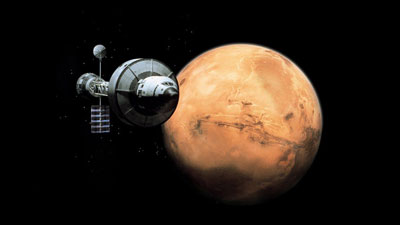Planet Hollywood, part 1: Mission to Marsby Dwayne Day
|
| At its best, near-future science fiction can give us a vision of what could actually, possibly, maybe exist. Alas, it is rarely at its best. Usually it is like these two movies, meaning “not good.” |
The movies were Mission to Mars and Red Planet. Despite the fact that both had A-list stars and hefty budgets, they both flopped. That pretty much sealed the deal for science fiction films set in the near future involving the exploration of the solar system, and it was not until this year’s well-reviewed, but little-seen Moon that we have had a more realistic science fiction film. (I’ll tackle Moon in a future article.) Both Mars films still get regular showings on cable television, but looking back nearly ten years later, it’s hard to say anything terribly flattering about either one. That said, Red Planet is the slightly better film, whereas Mission to Mars is barely watchable.
It’s not hard to guess at the origins of both of these movies. It usually takes about two to three years to make a movie. In summer 1997 NASA’s Mars Pathfinder rover landed on the surface of the fourth rock from the Sun and gained tremendous publicity for NASA. It undoubtedly led Touchstone Pictures and Warner Brothers to greenlight Mars-themed movies. Something similar happened when comet Shoemaker-Levy 9 smashed into Jupiter in 1994; in 1998 there were two movies about saving the Earth from an incoming space rock: Armageddon and Deep Impact.
If, like me, you think that it will be at least five to ten decades before humans set foot on Mars (and let’s face it—we are no closer now than we were back in 1989 when Mars was last on the agenda), then near-future science fiction has a certain allure. At its best, it can give us a vision of what could actually, possibly, maybe exist. Alas, it is rarely at its best. Usually it is like these two movies, meaning “not good.”
What follows is a detailed synopsis and review of Mission to Mars and Red Planet, filled with spoilers and snark.
Mission to nowhere
Mission to Mars should have worked. It had at least the basic ingredients of a decent movie, including an Oscar-winning and two Oscar-nominated actors in lead roles, a substantial budget, and great special effects. All of this was undercut by awful dialogue and a substandard script. Oh, and hack director Brian De Palma.
The movie takes place in the 2020s, and in an alternate universe where NASA is not starved for funding. The movie starts out in one of the most boring and draggy ways possible, with a going-away party for the first human crew to head to Mars. The scene is so loaded with exposition that it immediately begins to sink. We are briefly introduced to three of the crewmembers, but most of the camera time is devoted to astronaut Luke Graham, played by Don Cheadle, whom we are supposed to like so much that when he gets stranded on Mars later we don’t want him to die. After all, he has a wife and son at home, neither of whom are seen again after the first five minutes.
Apparently astronauts are millionaires, because although Dickinson, Texas is not exactly an expensive real-estate market, Luke still manages to own what must be a multi-million dollar home, and pay for world-class landscaping. His water bill alone must be obscene.
One of Mission to Mars’ biggest problems is the ham-fisted way in which the characters are portrayed. The audience is literally beaten over the head with certain messages about them. For example, the primary message of the party is that the three men are all really good friends, and everyone is really worried about the emotionally wounded member of their party, who lost his wife to cancer a year or so earlier.
| One of Mission to Mars’ biggest problems is the ham-fisted way in which the characters are portrayed. The audience is literally beaten over the head with certain messages about them. |
As previously mentioned, the party is cram-packed with exposition. We learn that there are two Mars crews, both with husband-wife teams such as Woody Blake (Tim Robbins) and his wife Terri. Woody’s Mars 2 crew is scheduled to eventually relieve the Mars 1 crew. We never meet the fourth member of the second team, but the reason for this is quickly apparent when astronaut Jim McConnell, played by Gary Sinise, drives up to the house in one of the ugliest cars ever made. There are several movie clichés competing for screen time all at once. For starters, despite the fact that the party has been going on for hours before Jim shows up, nobody else seems to have brought their car, making it convenient for him to drive all the way into the yard. He’s also in a big, blocky silver car that hums, indicating that this is “the Future.” But the biggest cliché of all is that Sinise looks like crap. He’s got a five o’clock shadow and looks like he’s been crying. This is quickly explained in the expository dialogue, which goes something like this: “Gee, Jim, it’s really awful that your wife Maggie died and as a result you dropped out of training for the Mars mission and aren’t going to Mars with us. But at least Luke here is the number one expert on colonizing Mars so he should be okay if anything goes wrong there.”
Of course, something does go wrong. We soon see Luke and his Mars 1 team on the surface of Mars when they stumble across something weird at a location named Cydonia (yes, you know what’s coming). They go out to investigate and stand around like a flock of pigeons staring down a jet engine as a powerful funnel cloud forms in front of them. What then follows are several of the dumbest deaths in recent science fiction film history. One character gets her helmet faceplate smashed in by a rock, another gets sucked up into the tornado. But the third dies in the goofiest way possible, spun around and around until his arms and legs fly off (it’s hard to resist yelling “Wheee!!!” when this happens). Not surprisingly, Luke (Cheadle) is the sole survivor. We also see that the tornado has exposed a giant humanoid face on Mars. (It is at this precise point that every space enthusiast with any hope for the movie groans “Oh god, no…”)
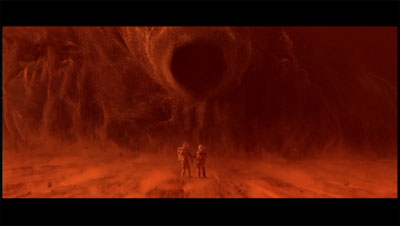 |
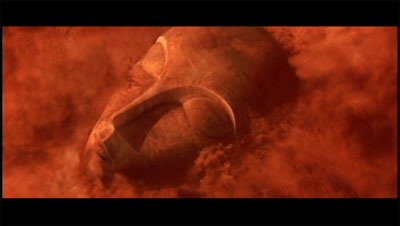 |
Cut back to the “World Space Station” in orbit around Earth. World peace must have broken out and NASA must have clearly gotten a budget increase, because this station is huge, including a giant rotating section. It’s also probably one of the coolest interior sets in the movie. Woody and his wife are up there, as is Jim, looking slightly less hangdog than earlier, indicating that maybe he’s finally starting to recover from the death of his wife. They get Luke’s distress call from Mars and decide to launch a rescue mission. Not surprisingly, the fourth member of the Mars 2 crew, whom we have never seen, gets bumped off the mission in favor of Jim (Sinise).
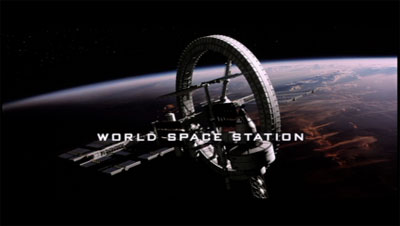 |
 |
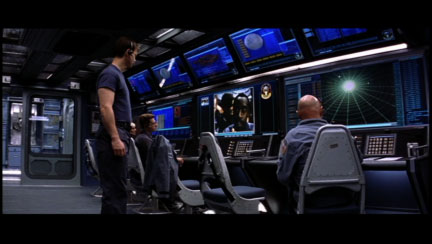 |
Gary Sinise probably got the job playing McConnell because of his stint playing astronaut Ken Mattingly in Apollo 13, but he’s truly awful in Mission to Mars. There are several scenes on the space station where his attempts to look mournful come across as if he’s suffered a brain injury.
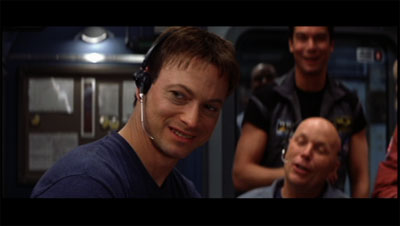 |
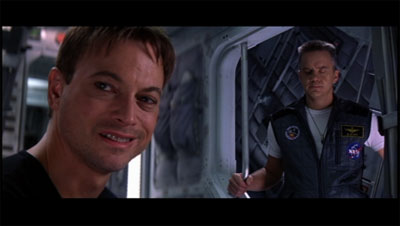 |
We next join the Mars 2 crew as they’re on their way to Mars. What follows are more clunky attempts to make the audience like the characters. We are literally hit over the head with several messages. The party was supposed to convince us that Woody, Luke and Jim are the best of friends. Later scenes of Woody and his wife Terri (played by Connie Nielsen) are supposed to convince us that they are deeply in love. We’re also introduced to the fourth member of the Mars 2 crew, Phil Ohlmyer, played by the badly outclassed Jerry O’Connell. Phil is a lovable goofball who is a whiz with electronics. (Got that? Obviously it’s important later on.)
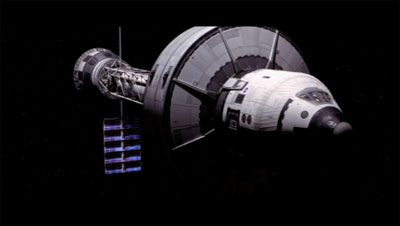 |
Tim Robbins won an Oscar, but his scenes with Nielsen, where the couple are constantly cheerful and making googly eyes at each other, just don’t work. Certainly the dialogue does not help, but there’s clearly something larger at play here that can probably be laid at the feet of director Brian De Palma.
| The scenes aboard the Mars 2 spacecraft show off the one area where the film does a decent job. Mars 2 looks like a real spacecraft, one modeled on the look of the International Space Station and the Space Shuttle. |
There are a lot of different aspects to being a good director. Some directors are great at logistics, bringing together an army of people and resources to produce highly complex films. Some directors are technical wizards, inventing new technology to do new things. Some have wonderful visions and know exactly where to place the camera or how to light a scene. And some directors are great at getting performances out of their actors, knowing just how to elicit an emotional response, or just what to say to an actor to put them in the character. I don’t know what kind of director De Palma is, but he is clearly not an actor’s director. So many of the character interactions in the film simply do not feel real. They feel like people reading lines, rather than people who actually know and work together, and like each other. In fact, the liking each other part is one of the problems with the film. The Mars 2 crew doesn’t feel like a crew, like people who are forced into a situation and occasionally disagree or bicker or just have to shut up and accommodate each other. They feel like actors in a dinner theater production of Death of a Salesman.
The scenes aboard the Mars 2 spacecraft show off the one area where the film does a decent job. Mars 2 looks like a real spacecraft, one modeled on the look of the International Space Station and the Space Shuttle. The overall ship design was clearly inspired by the Discovery in 2001, although not nearly as elegant. Mars 2 has a large fore section, a long thin spine, and an engine section in the back. Mars 2 also features a rotating section behind the cockpit, and although it is not nearly big enough to provide useful gravity without making everybody motion sick, the filmmakers get props for trying. In the end, it is a poor man’s version of Discovery.
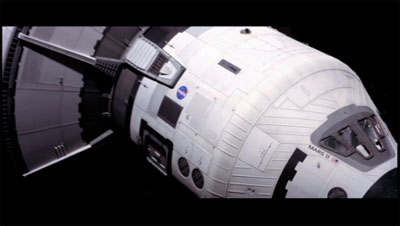 |
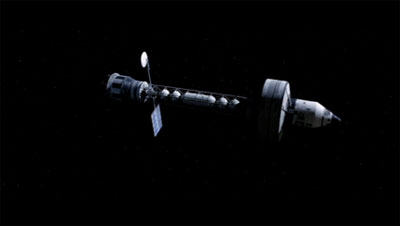 |
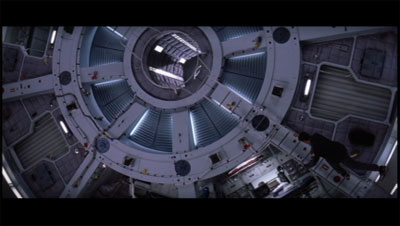 |
One of the reasons that Mission to Mars had buzz within the space community was because Robert Zubrin served as a technical advisor to the film. But science and technical advisors—and accuracy—are never allowed to get in the way of a story, and although it is possible to see some of Zubrin’s influence on the movie, he certainly cannot be blamed for its technical excesses.
One thing I’d like to know is who can be blamed for the music selection. In 2001, Stanley Kubrick demonstrated his brilliance by playing the Blue Danube Waltz as a spaceplane lined up with a rotating space station. In Mission to Mars we are introduced to Mars 2’s centrifuge with a long tracking shot accompanied by… Van Halen’s “Dance the Night Away.” Now I have been known to enjoy the occasional Van Halen tune, but this song sucks. Once again it is used to demonstrate to us that Woody and Terri really really love each other, as they perform a zero-g dance to a crappy song that would be half a century old by the time the film takes place.
What follows next is supposed to be the most exciting part of the movie, but is so slow and badly paced that it is hard to stay awake long enough to see what happens. Shortly before reaching Mars, the Mars 2 spacecraft is suddenly smacked by meteors—a science fiction cliché that dates back to the 1950s. The crew struggles to fix several leaks in their spacecraft as the computer crashes. Woody performs an emergency EVA to fill in the holes with a high-tech caulking gun. What should have been a tense scene is simply dull.
Part of the problem is the music. De Palma recruited legendary composer Ennio Morricone, perhaps best known for his theme for The Good, The Bad, and The Ugly. Morricone’s score for Mission to Mars is horrible and the meteor scene is proof. While the characters are in danger, it sounds as if Morricone is noodling away on a Casio keyboard. The scene is supposed to say “peril” but the music says “boredom.” Morricone phoned this one in.
| n 2001, Stanley Kubrick demonstrated his brilliance by playing the Blue Danube Waltz as a spaceplane lined up with a rotating space station. In Mission to Mars we are introduced to Mars 2’s centrifuge with a long tracking shot accompanied by… Van Halen’s “Dance the Night Away.” |
Woody, Jim, and Phil fix the ship, but have to hurry up to perform the rocket burn that puts them in Mars orbit. They strap in and Woody gives Jim the honor of pressing the button. But the fuel lines have been damaged and the rocket engines explode. Mars 2 is careening toward the Red Planet. They quickly come up with a plan—they’ll jump ship and hop aboard a robotic resupply module in Mars’ orbit.
A friend of mine saw a special screening of Mission to Mars with a NASA audience and later said that the next scene, of the Mars 2 crew performing an EVA so that they could catch the resupply ship, actually drew guffaws from the audience. It’s not hard to see why. Think of it this way: you’re on a commercial jetliner flying to Los Angeles when both your engines catch fire. So you come up with a rescue plan that involves jumping out of the airplane and catching a jetliner flying to Chicago. All you have to do is time everything right… It’s a plan so crazy, It Just Might Work!
Keep in mind that Mars 2 never even entered Mars orbit. It is careening full speed past the planet. The closing velocities between it and the resupply ship would be in the thousands of kilometers. But still our heroes manage to fly toward the robotic ship in their spacesuits and catch it.
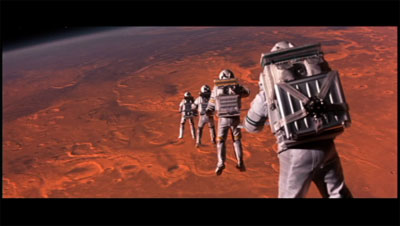 |
Well, not all of them. Woody becomes untethered and floats away. Terri—who loves him soooo much, remember?—flies after him, but gives up when she is about two meters away from saving him. Woody realizes that his wife won’t abandon him, so he commits suicide by removing his helmet. Terri is devastated, but returns to the ship.
Anybody else see all that flirting between the happy couple and realize that they were going to be pulled apart by tragedy? Anybody? We should consider ourselves lucky that we didn’t have to suffer more of these two actors trying to convince us that they’re in love.
So our three remaining heroes make it down to the surface and somehow land within walking distance of the Mars 1 base camp.
